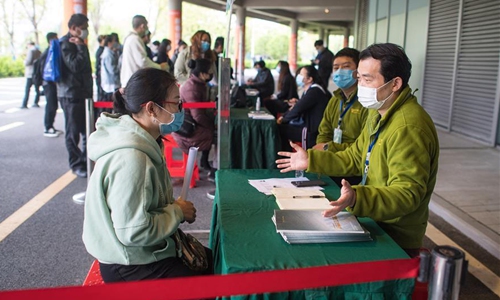Why is China’s service sector employment resumption slow?
By Yao Yang Source:Global Times Published: 2020/4/25 17:05:48

A staff member from a company communicates with a job applicant at an on-site job fair in Wuhan, central China's Hubei Province, April 21, 2020. Photo:Xinhua
The COVID-19 pandemic has severely hammered the world and China's economy. The country's GDP in the first quarter of 2020 posted its first decline in decades as the virus halts economic activities. Meanwhile, prospects for the US and European countries are even more dismal. Boosting economic recovery has become the top priority at every governmental level.
The suspension of economic activities among the US and European countries has caused a significant drop in external demand. China's second quarter economic growth faces major challenges.
Although China's domestic work resumption rate in the manufacturing sector is close to 100 percent, service sector numbers remain low. The largest drop in China's economy during the first quarter was retail sales of consumer goods, revealing the biggest problem facing the economy is consumption. Accelerating work resumption, especially in the service sector, is chief among the challenges.
The main reason for the service industry's slow recovery is that consumers are worried about the virus and are unwilling to increase offline consumption. Second, local governments continue to implement strict virus prevention measures, which create uncertainty for business resumption.
The national government has introduced fiscal and monetary policies to support the economy. Fiscal policies boost demand, while monetary policies secure liquidity for businesses. However, the policies have leaned toward investment while providing less consumption support, which accounts for over half of China's GDP and has contributed 70-80 percent of GDP growth in recent years.
Additionally, the retail service sector is closely tied to consumption. Weak consumption indicates low employment in the service industry. Amid pandemic prevention efforts, the two are like both sides of the same coin.
Consumption decline and concerns over a second outbreak have made boosting consumer confidence the primary task.
The first step would be to disseminate knowledge on scientific pandemic prevention efforts and ease public anxiety. If scientists are correct, COVID-19 will not be wiped out this year. Under such circumstances, society will have to learn how to coexist with the virus.
Second, anti-pandemic requirements for businesses and service sites need to be reduced. Other than implementing necessary prevention measures, suspending businesses or services due to new virus infections would not be effective.
Third, fiscal subsidies could be introduced to help boost consumption. Besides handing vouchers and preferential policies to promote consumption, the government should offer cash to low-income groups to boost spending. The government could issue 1.4 trillion yuan ($198 billion) in special bonds that would provide 2,000 yuan to the lower 50 percent of Chinese who earn lower incomes. It is fine to raise China's fiscal deficit to 3 or even 5 percent of GDP.
The author is the director of the China Center for Economic Research at Peking University. bizopinion@globaltimes.com.cn
Posted in: EXPERT ASSESSMENT